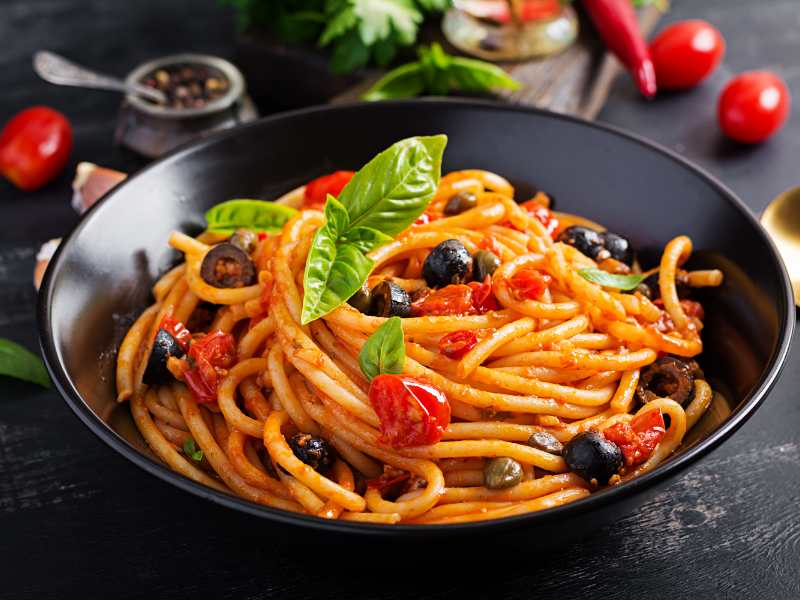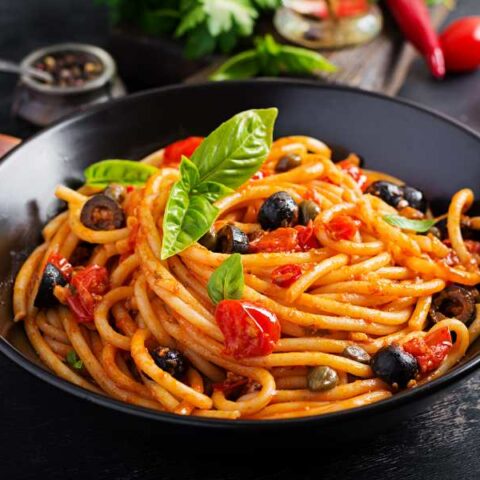Italian Spaghetti alla Puttanesca Recipe

Spaghetti alla Puttanesca is an Italian pasta dish known for its salty sauce containing olives, anchovies, capers, peppers and garlic. The mixture of olive and anchovies bring an umami flavor to the sauce while the garlic and pepper make for an aromatic meal. This dish is eaten as the main course for an evening meal and might be accompanied by small appetizers or wine.
Being as well-known as it is, spaghetti alla puttanesca has many regional variations. The dish itself is also known as aulive e chiapparielle in Campania, literally meaning olives and anchovies. The sauce, known as sugo alla puttanesca by itself, has a Neapolitan version that excludes the anchovies.
In Sicily, raisins might be added. While spaghetti is the most popular pasta option to pair with the sugo alla puttanesca sauce, it is also possible to use other pasta such as vermicelli, linguine, or penne in its place.
Origin & Cultural Significance
Spaghetti alla Puttanesca originated in Naples, Italy sometime in the early to the mid-20th century. Food historians have proven this origin by tracing mentions of the sauce through anecdotes and mid-20th-century cookbooks, where the sauce begins to be mentioned. However, there are some suspicions that the sauce might have been around for longer, although there is no substantial evidence to prove it.
The common tale around this dish is that it was created nearly by accident in a small working-class neighborhood in Naples. A restaurant owner was closing down for the night when some drunk people walked up and demanded something to eat.
Of course, the cook was out of most ingredients for the day, but the group just told him to throw together whatever he had. Thus came the initially odd combination of olives and anchovies, a salt concoction tempered by the tomato of the sauce. The dish became a hit and was added to the restaurant’s menu, and from there, it spread.
This could also explain the rough meaning of the dish’s title. Puttanesca is an adjective derived from puttana, the Italian word meaning whore or prostitute. One theory posits that prostitutes would serve it to their customers because the ingredients were cheap and it is quick to make. However, the word puttana and its derivatives are used as curse words similar to the meaning of garbage or the English curse word ‘shit‘. So, another theory states that the late-night customers asked for whatever puttana the shop owner had left around.

Italian Spaghetti alla Puttanesca Recipe
Spaghetti alla Puttanesca is an Italian pasta dish known for its salty sauce containing olives, anchovies, capers, peppers and garlic.
Ingredients
- Spaghetti - 1 lb.
- Onion, diced - 1
- Garlic (crushed) - 3 cloves
- Chili flakes - ½ tsp
- Chopped tomatoes - 14 oz.
- Black olives - 5 oz.
- Anchovy fillets (salted) - 5
- Capers - 2 tbsp
- Parsley, chopped - 1 bunch
Instructions
- Heat oil in a medium to large pan over medium heat. Add the onions and saute until transparent, about 5 minutes. Add in the chili flakes and garlic, cooking for another 4-5 minutes.
- In the same pan, add the tomatoes, anchovies, capers, and olives. Simmer for 15 minutes, until soft and aromatic. Adjust seasoning according to preference.
- While the sauce is simmering, prepare your dried spaghetti according to the package directions.
- Once the sauce has simmered and the pasta has boiled to al dente, drain the spaghetti and add to the pan with the sauce. Toss together and serve immediately. Use the chopped parsley to garnish the dish and enjoy!
Nutrition Information:
Yield: 4 Serving Size: 1Amount Per Serving: Calories: 257Total Fat: 5gSaturated Fat: 1gTrans Fat: 0gUnsaturated Fat: 4gCholesterol: 4mgSodium: 561mgCarbohydrates: 44gFiber: 5gSugar: 5gProtein: 9g
Nutrition is provided and calculated by Nutritionix. It is for general information purposes and is only a rough estimation.






